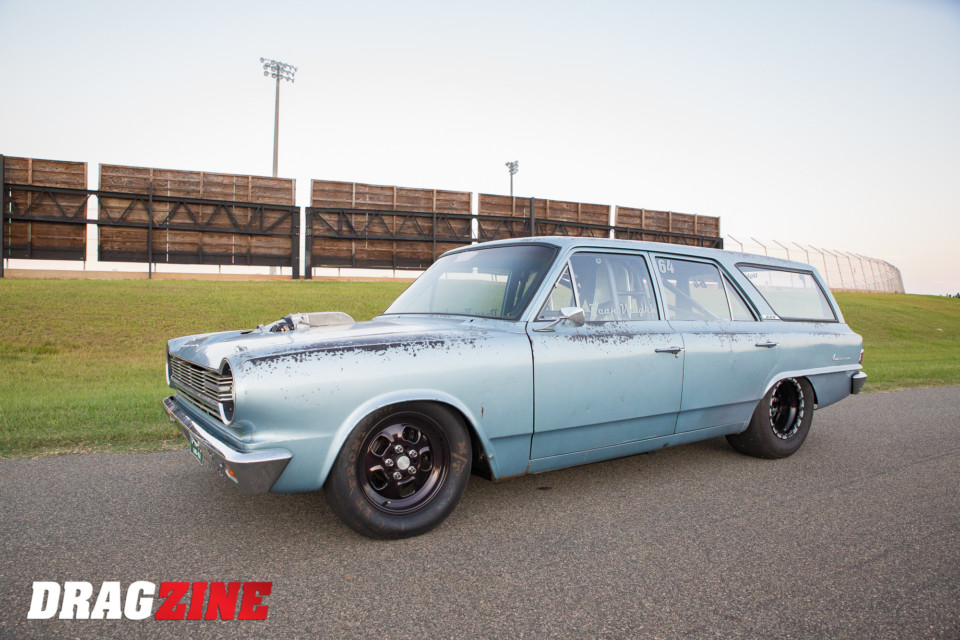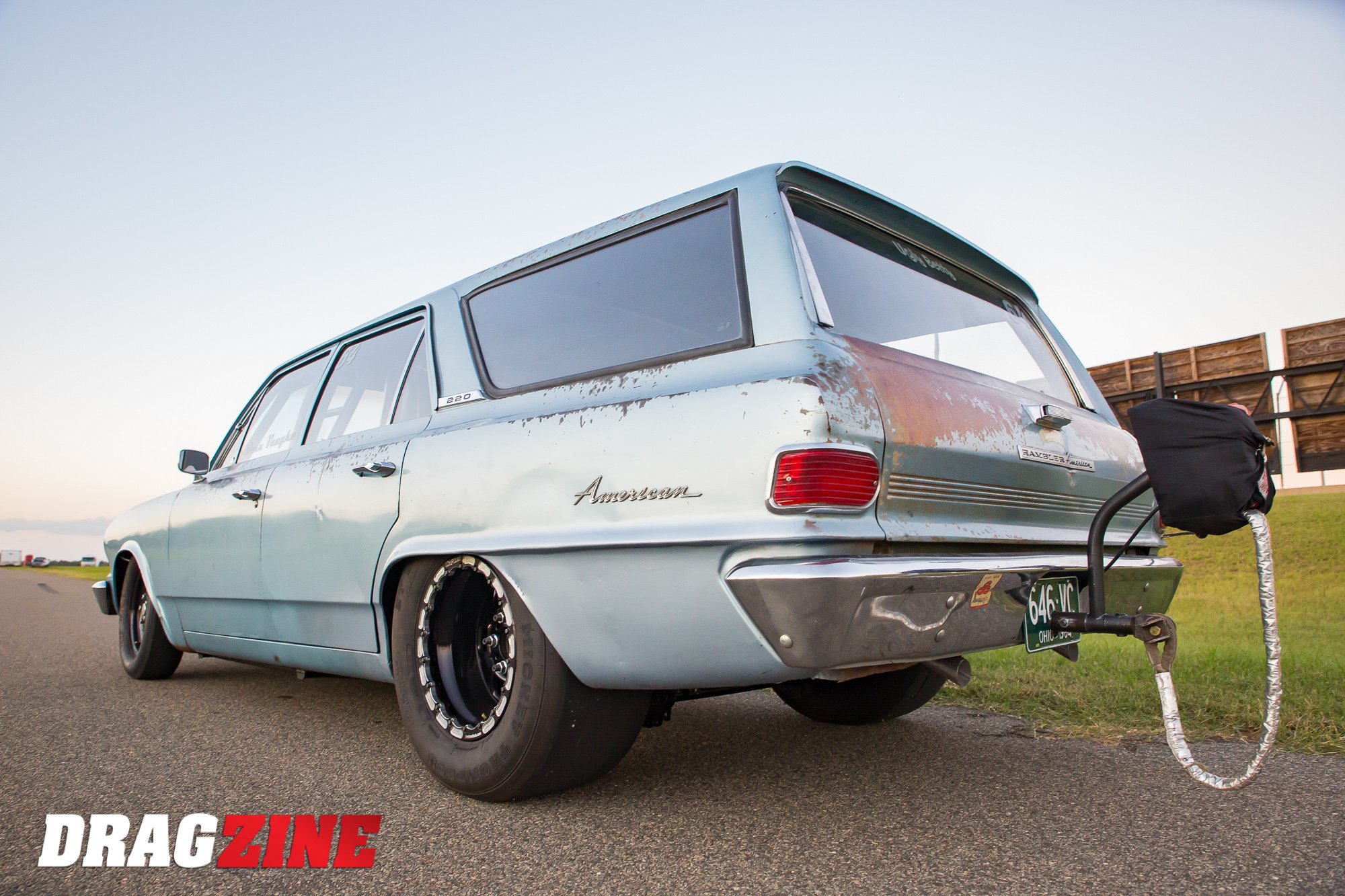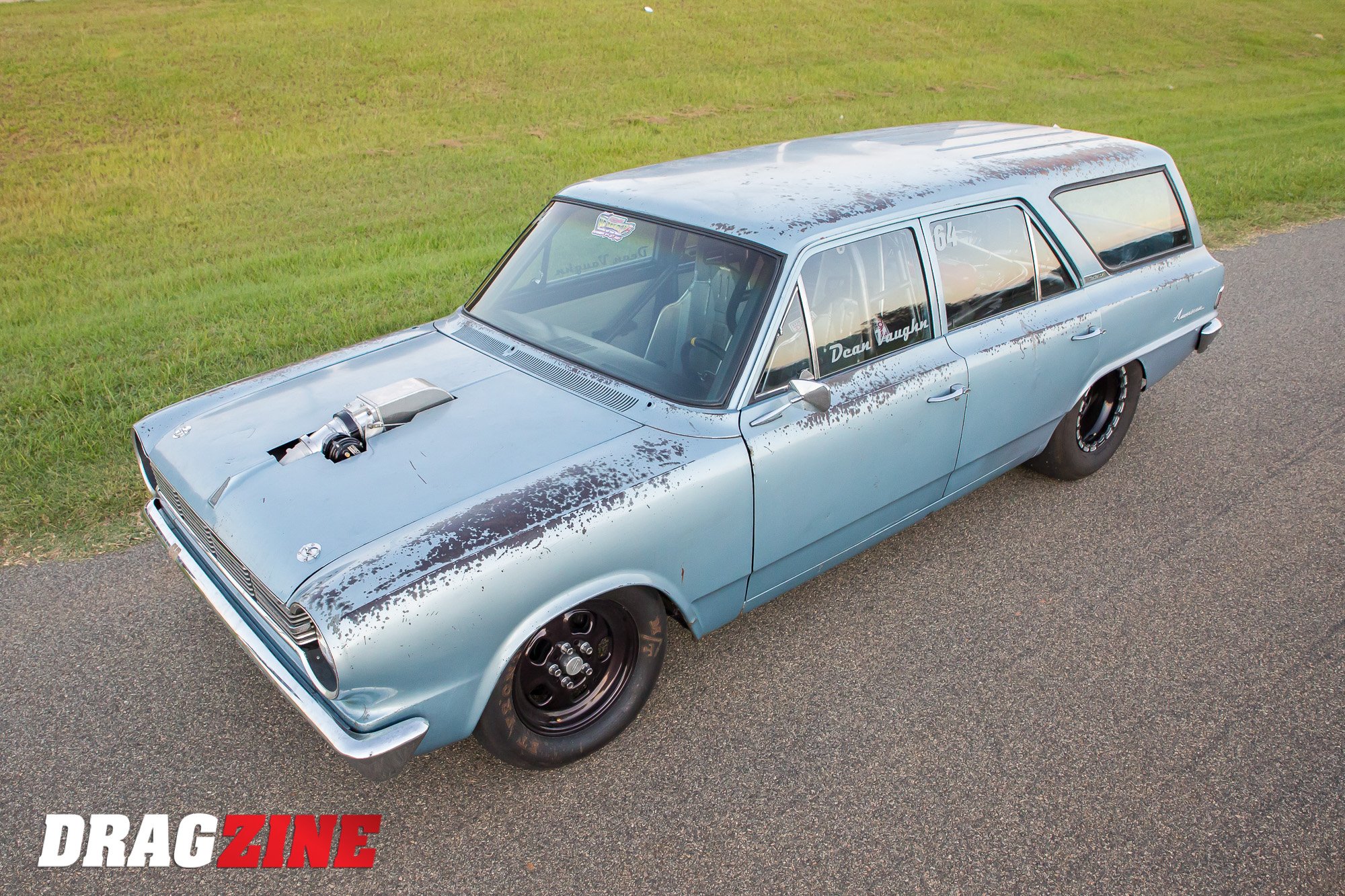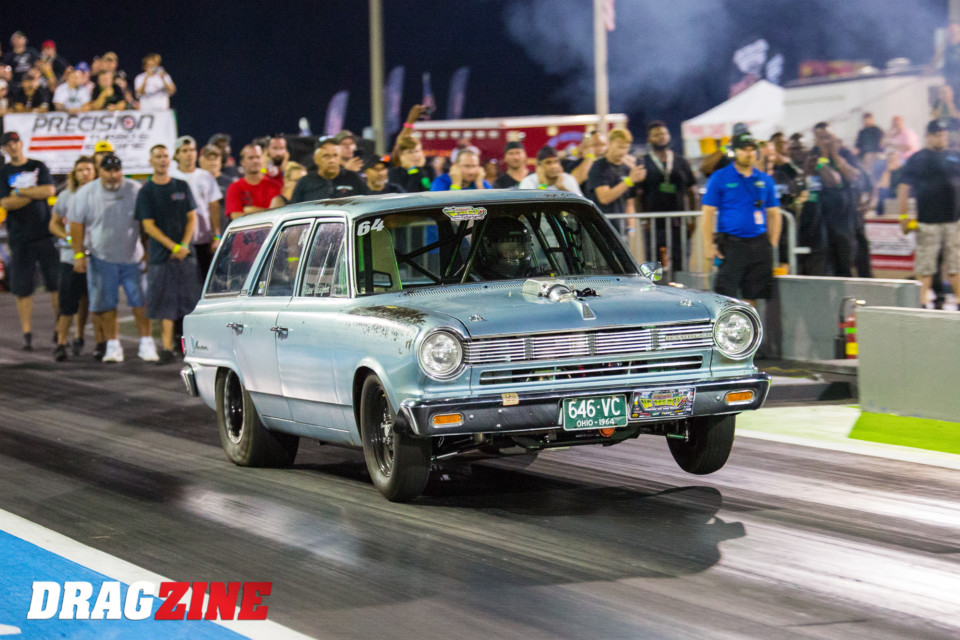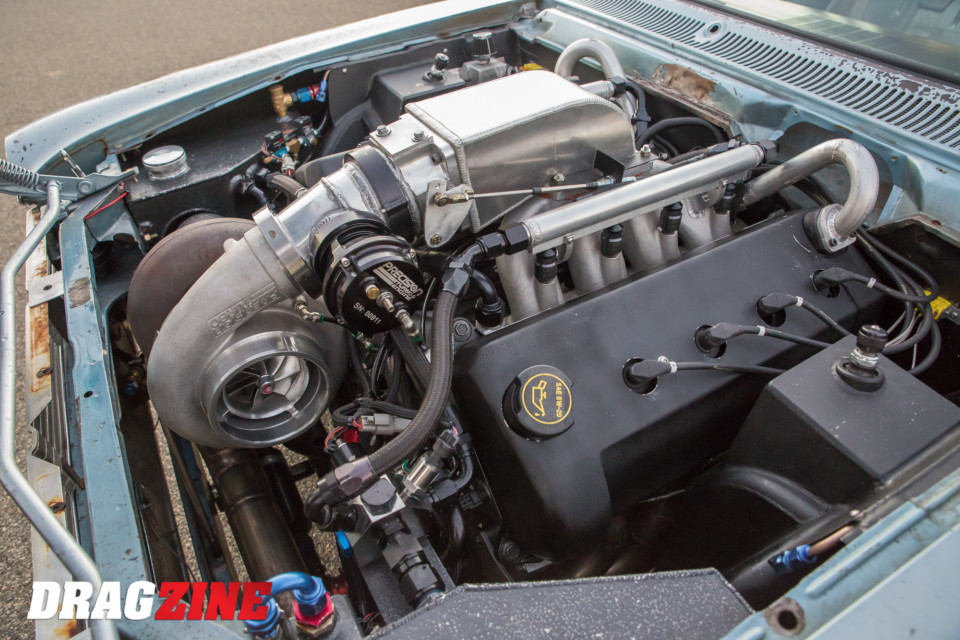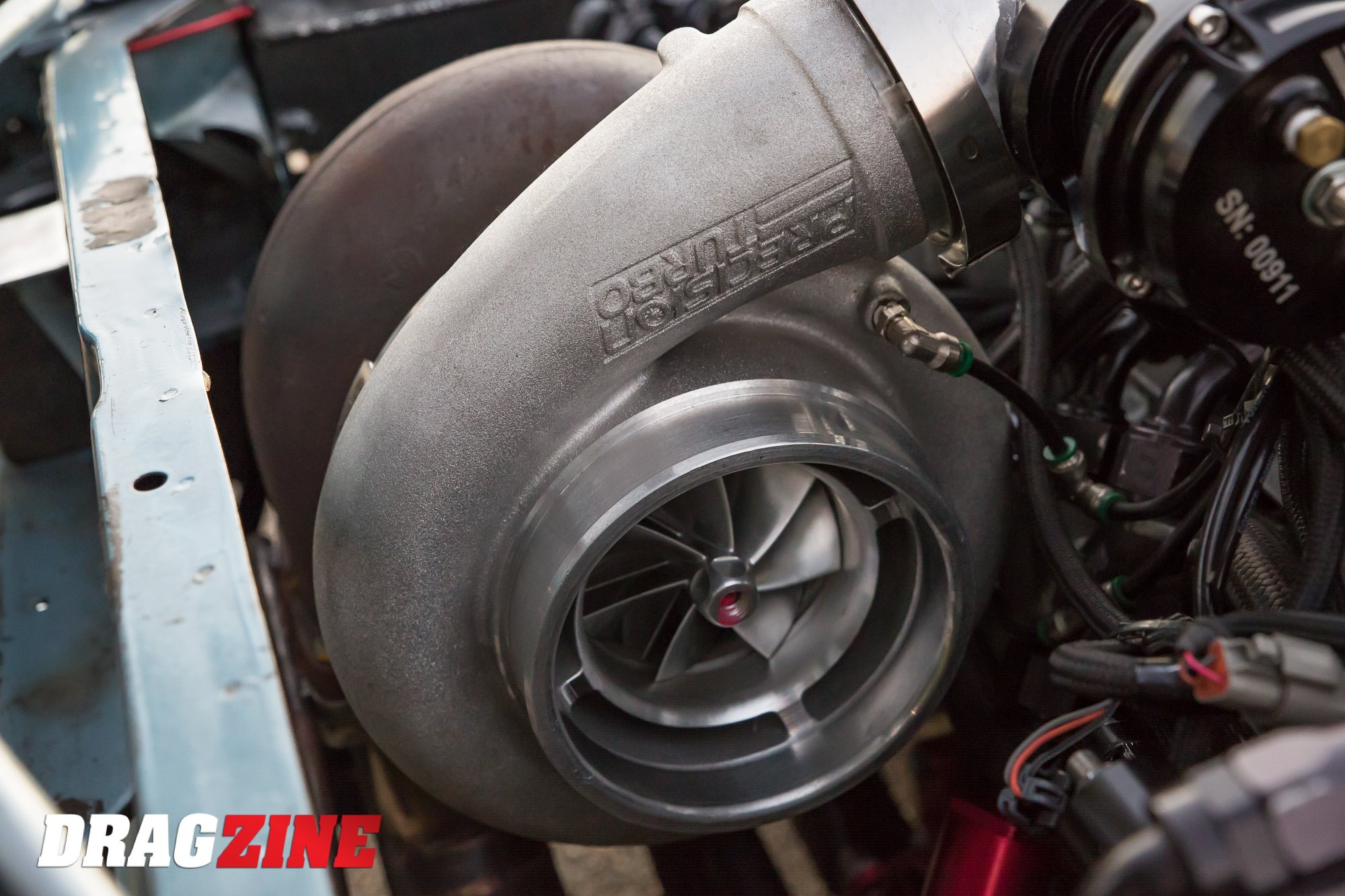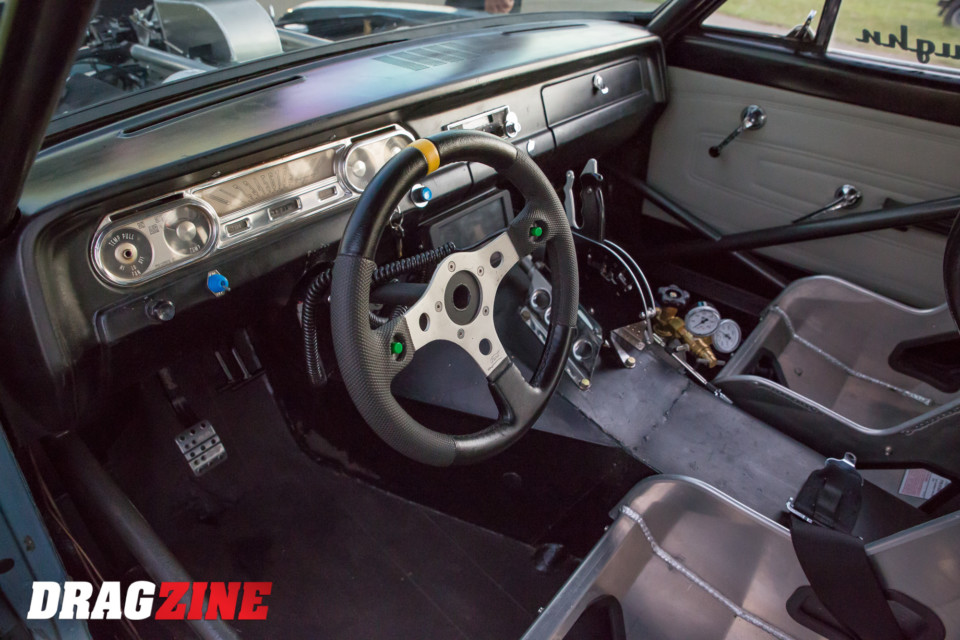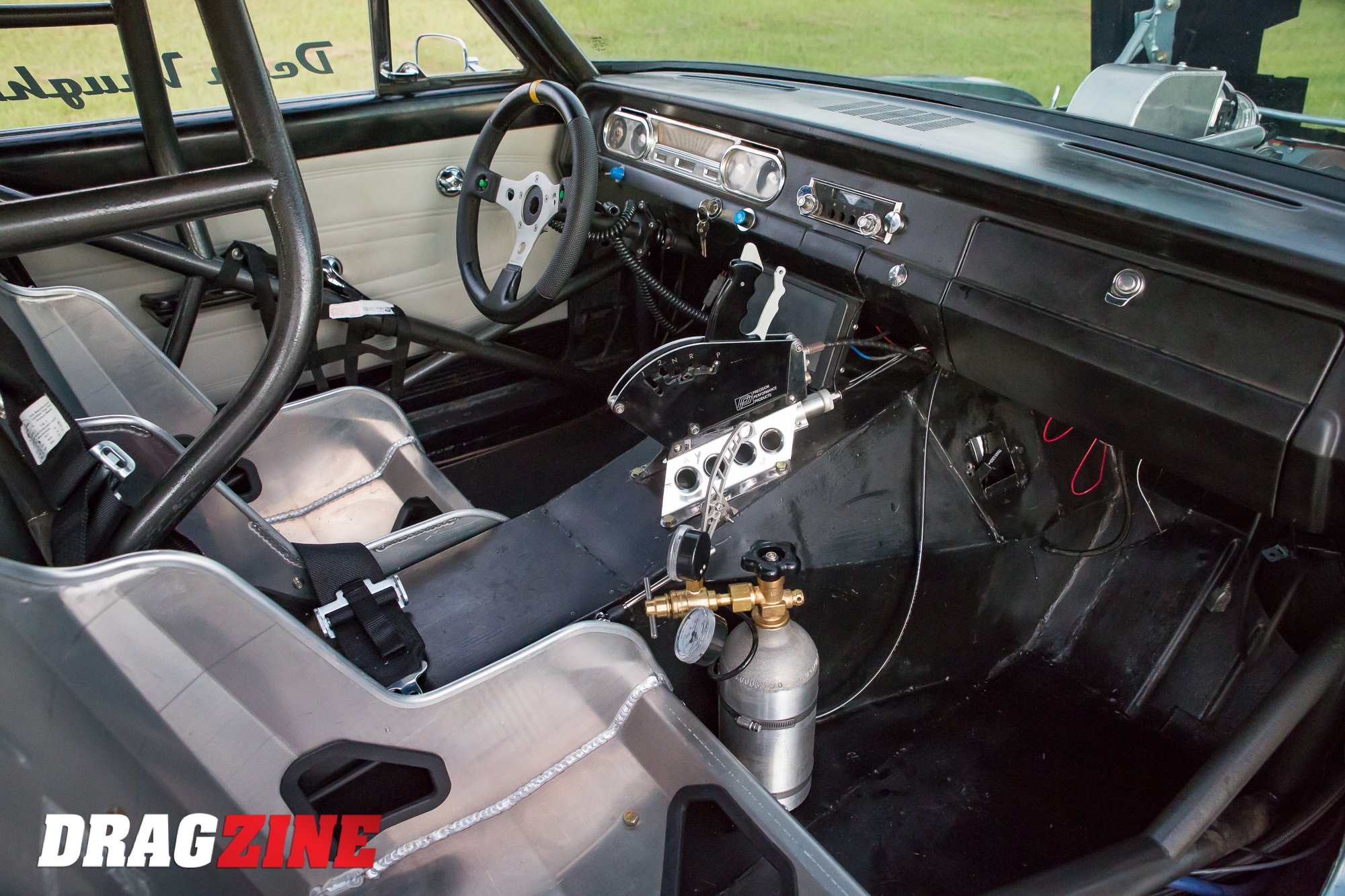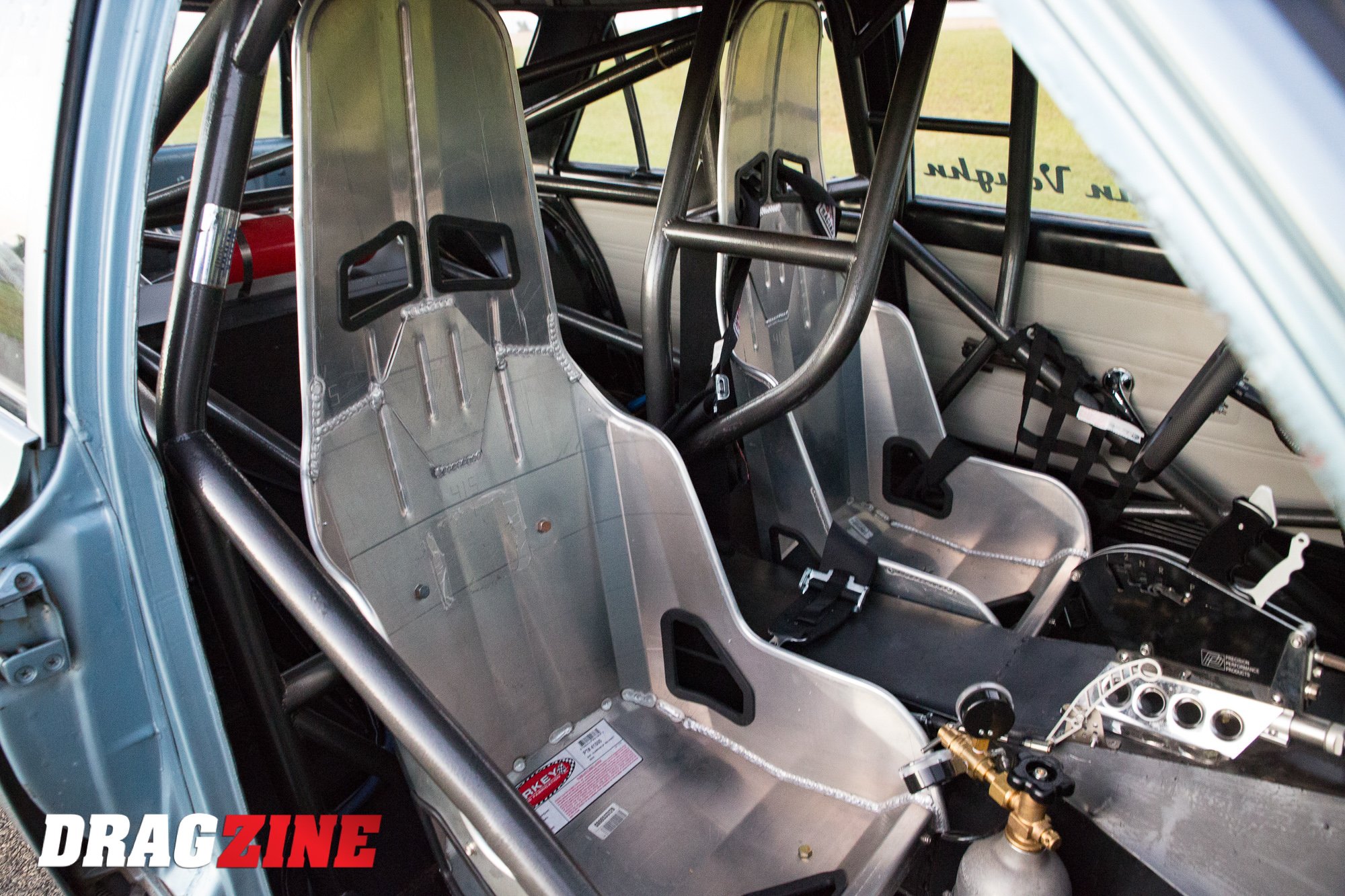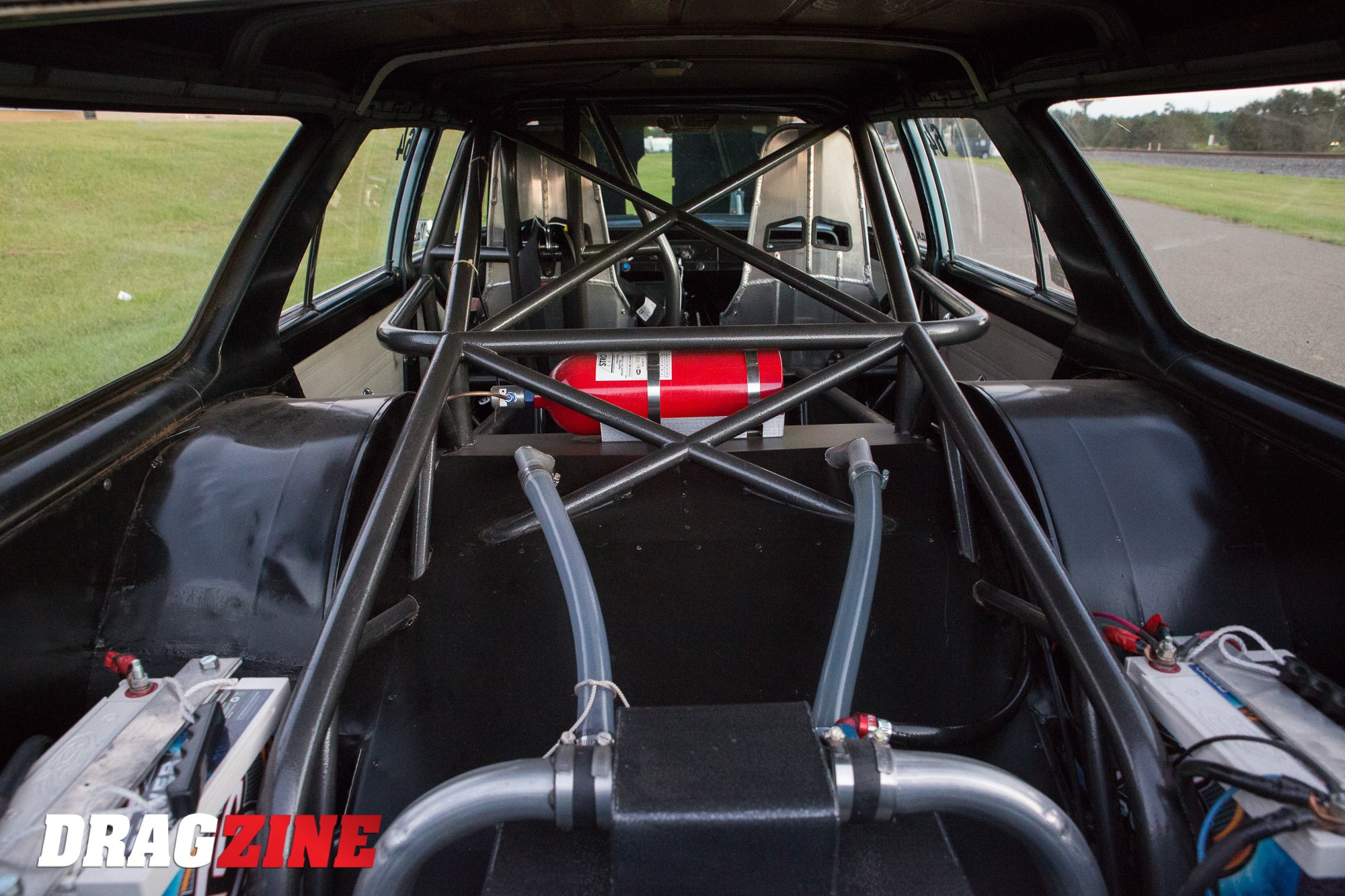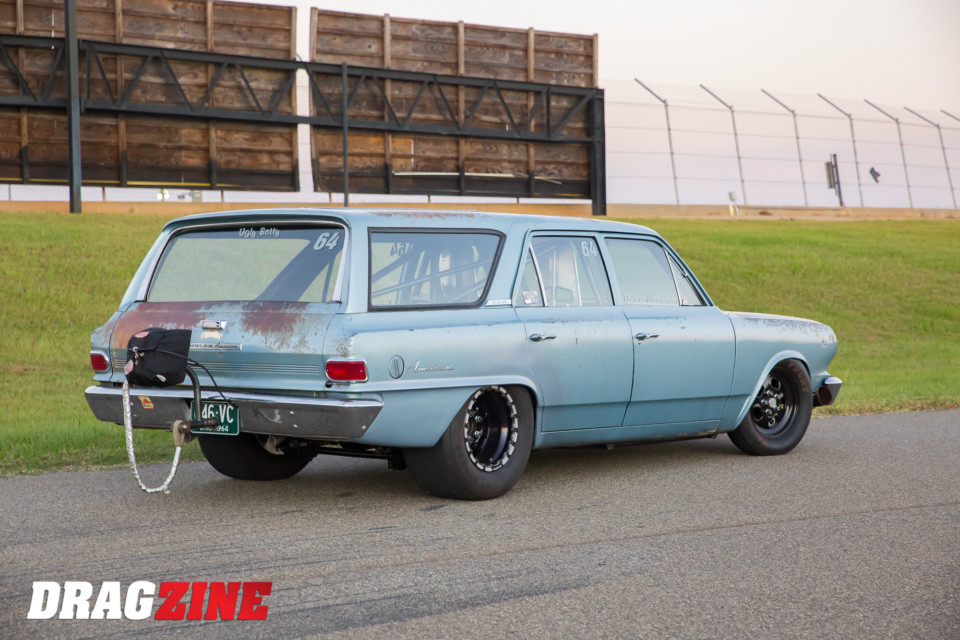The AMC Rambler wagon population in drag racing is roughly akin to a forgotten speck on a map that only a lost traveler stumbled into on accident, but that’s perfectly alright by Ohio no-time racer Dean Vaughn, who accurately refers to the old-school Rambler as “an economy car comparable to a Chevy Cobalt or the Chevette.”
Produced under the Rambler brand name as the Rambler American by American Motors Corporation, these compact economy cars (they actually won multiple fuel economy competitions, thus cementing their status) were initially by no means lusted-after hot rods; they were cheap, often the lowest priced American sedans on the lot, and they’d go a long way, relatively speaking, on a tank of fuel. However, in 1964 — the year Vaughn’s wagon was built — Rambler began optioning V8 engine packages into its cars, ranging from 290- to 390-inches in displacement. Rambler American still heavily marketed the fuel economy aspect of their cars, but with the right options, they weren’t exactly a push-over anymore.
Some 54 years later, Vaughn is still out to prove the Rambler American is no push-over. And while an economy car it is not, his 220 wagon still gets down on the street from time to time.
Hailing from Sardinia, Ohio, Vaughn runs in the rough-and-tumble world of small-tire no-time and grudge racing with his patina-colored wagon — he says the faded blue and rusted patina look is no recreation, but rather, au natural, the result of more than half a century of weathering.
For Vaughn, the unique wagon is but a chapter in a long racing saga that’s spanned much of his adult life; in the 80s he competed in Pro Stock Motorcycle and later toyed around in Pro Modified in its early years before gravitating to the early incarnations of the fastest street car movement. Since that time, door cars of the street-ish variety have been his kryptonite.
“My brother got me into drag racing. He was a huge influence in my life and it was something that we both had in common. I’d tag along with him when I was young — he had a lot of old hot rods back in the day and I just gravitated toward it. It’s the only hobby I have,” Dean shares, adding, “it’s really the camaraderie of the sport that I enjoy. You can go to a racetrack and literally the guy right beside you will loan almost every spare part he has to you knowing he has to run you in the next round. And we’d do the same for them, and to me that’s just a lot of fun.”
A handful of years ago, Vaughn was campaigning a GMC Sonoma step-side bed pickup in various Ultra Street and Outlaw 8.5-inch tire series with some success, but medical issues forced him to step away for a time. Recovered, he later plotted his return and, intrigued by the AMC brand and its vehicles — of which he’s owned several, noting, “I’ve always loved AMCs — he set out to look for something just a bit different. Vaughn’s son-in-law discovered the wagon in 2014 and following a brief exchange with his older brother — who questioned why he hadn’t already purchased it — the car became part of the family.
“I bought the car to make a nice 10-inch tire race car out of it. It came from a small town in Nebraska and belonged to a doctor who had purchased it new. He had operated sort of like a mid-wife, traveling to houses to deliver babies, and that’s what he bought the car for. It was very plain-jane; it had a flathead four-cylinder with a 3-speed on the column and had one option, called the holiday option, which meant it had a 3-gallon larger gas tank than standard, a tow hitch installed, and the front seat would lay back into the back seat to make a bed of sorts.”
Vaughn bought the car from the doctors’ grandson with 40,000 original miles on the odometer.
After a less-than-enjoyable experience with two chassis shops that were enlisted to transform the car into a racing thoroughbred, Vaughn finally said enough was enough and hauled it back home, where he and a group of friends completed the project — a 25.2-spec chrome-moly chassis and the works — in his two-car garage.
Vaughn and company were careful not to molest AMCs artwork, leaving virtually all of the factory steel in place. The bumpers are original, all of the windows roll up and down, the tailgate opens, the stock dash, albeit now removable, still resides in the car, and the original keys are still used to fire it up. The horn even still works.
I had never owned a Mod motor or a turbo in my life — I had always been a small-block or big-block nitrous guy, and Tony [Bischoff] warned me when we built it that this thing was going to be an animal with that turbo on it, and he wasn’t wrong at all — it’s shocked everybody.
A raised and widened, all-steel transmission tunnel was fabricated to make servicing a cinch, and the complete K-member-style front suspension was designed to unbolt from the car. Breather tubes from the valve covers are plumbed into the chassis, similar to nitro or Pro Modified cars, routing back to a double-baffled holding tank that was fabricated and situated in the rear of the car to catch any and all fluids in the event of a catastrophic engine failure. Another unique element, Vaughn took 1989 Buick hood hinges and set up the heavy, factory hood to tilt open to the front for easy engine access; topping that off, he constructed a tool tray that hangs from the hood to put all of his tools within arms reach.
The powerplant, as Dean notes, is loosely based off of a 4.8-liter Ford Modular. Assembled by esteemed horsepower guru Tony Bischoff, the mill is built around a Sean Hyland block mated with a Sullivan intake manifold and Bischoff-massaged factory cylinder heads off of a Lincoln Navigator. The camshafts, custom-ground to Bischoff’s specifications, were manufactured by LSM. “It’s 10:1 compression, really a mild motor, Dean comments,” adding, “it has tags on it and I get in it and drive it around the little town I live in. Of course, it’s running on alcohol so you aren’t going to drive 100 miles away in it, but it can be driven.” Bischoff utilized a Bryant crankshaft and Manley rods and Ross pistons for the build.
Dean adds, “a lot of people don’t know it, but this is actually the very motor that Tony entered the Engine Master’s Challenge with several years ago and won. It was naturally-aspirated at the time, and after he won and I bought the Rambler, we were kicking around ideas trying to decide what kind of motor would be really neat for this car. He told me, ‘I’ve got just the ticket,’ and we hashed out a plan, changed it over from naturally-aspirated to a turbo program and it went from there.”
A Precision mid-frame 94mm turbo provides the boost, with Precision 44mm wastegates managing the boost levels. Radial tire racer Frank Soldridge fabricated the headers and the rest of the hot-side of the turbocharger system. On alcohol, it of course does not have an intercooler, and so Soldridge worked to keep the hot-side as short as possible to manage any heat concerns under the hood — a fact which is displayed well in the proven streetability of the car.
A Holley Dominator EFI system controls the engine functions, and Billet Atomizer fuel injectors deliver the fuel to the intake via a Waterman mechanical fuel pump, while a 105mm Wilson Manifolds throttle body permits the air to enter the intake and the combustion chamber. Holley coils, part of the Dominator EFI system, provide the spark to light each cylinder.
Adam Maurer at S&M Motorsports in Ohio dyno-tuned the Rambler for Vaughn, arriving at a setup he says he “hasn’t had to touch as far as getting the air-to-fuel ratio right, or making it run aggressively. It starts like a street car … there’s no hard-cranking or anything…it idles good. If you see it you’d have no idea that it’s a serious contender in the 10.5 ranks.”
Vaughn, who routinely campaigns the car in no-time style events, stops short of sharing specific power and torque numbers, alluding only to the fact that it “makes a lot of power and a lot of torque,” adding, “it’s far exceeded our expectations, I’ll tell you that much.”
…it’s really the camaraderie of the sport that I enjoy. You can go to a racetrack and literally the guy right beside you will loan almost every spare part he has to you knowing he has to run you in the next round.
“I had never owned a Mod motor or a turbo in my life — I had always been a small-block or big-block nitrous guy, and Tony warned me when we built it that this thing was going to be an animal with that turbo on it, and he wasn’t wrong at all — it’s shocked everybody,” he shares.
Vaughn tunes the car with assistance from Lonnie Diers from Extreme Automatics — who is also responsible for the two-speed Turbo 400 transmission that transfers the horsepower back to the Moser Fab-9 rear end housing filled with Moser gears, spool, and axles. Ultimate Converter Concepts built the billet bolt-together torque converter.
The front suspension is comprised of Racecraft spindles, controls arms, and other components, paired with Menscer Motorsports shocks, struts, and springs. A Flaming River manual rack and pinion allows Dean to control the car on its licks down the 1/8-mile. Out back are hand-built ladder bars with Menscer shocks and springs. Wilwood brakes at all four corners bring it to a halt; Weld Racing Rod-Lite wheels — black-anodized to set off the patina look of the car — are bolted on front and rear and wrapped in Mickey Thompson rubber (drag radials and slicks are utilized, depending on the class and track conditions).
In addition to no-time events, Vaughn has competed in no-prep and grudge contests with his wicked-quick Rambler; while he’s eyed Limited Drag Radial or perhaps even somewhere within the NMCA to go class racing, he says the very nature of no-time racing — keeping your performance a secret — has him shoe-horned into that scene at present.
In a sport where Rambler wagons are already one-of-few Dean’s turbocharged behemoth is truly one-of-one, putting emphasis on quality where there is no quantity. And no matter what it lights the boards at — or doesn’t light them at all — his wagon was done his way, and that kind of satisfaction with the end result and the journey in getting there is truly what hot rodding is all about.

